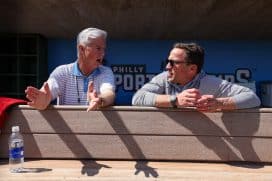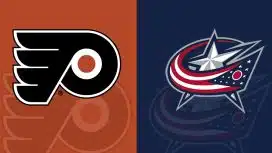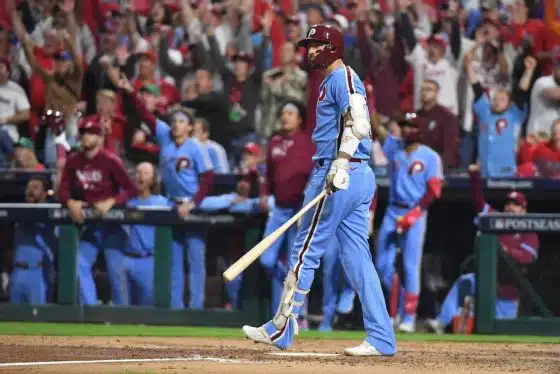Sixers
No Snipers, No Problem. 76ers’ Defense, Bully-Ball Mentality Make up for Perceived Lack of Outside Shooting
By Scott Cashin, Sports Talk Philly Staff Writer
The adage in business teaches us to buy when everyone else is selling. When going against the crowd, there is less competition for resources and an abundance of trade partners where favorable terms can be found. It has become a three-point shooting league. The team to emerge from this offensive movement will be the one that can force the opposition off the arc with elite defense and into the unfamiliar mid-range game where the reward is 33% less.
The lost art of defense, once highly valued in the NBA, has been replaced with three-point shots at volume. Teams are too eager to trade quick attempts in the hope of putting up rapid points on the scoreboard. But when teams are cold – they are freezing. If you take away the three-point shot, do they even know how to play in the mid-range? Successful teams take and convert the open shots given to them.
The Philadelphia 76ers underwent an overhaul this offseason. The team got taller and longer. Along the way they parted with JJ Redick and Jimmy Butler, leaving many to wonder where will the shooting come from? While still armed with an abundance of players who can score, none on the roster shoot above average from deep. This may sound alarming given the style of today’s game, but I am going to tell you that it is okay that the team is lacking the traditional outside threat. Redick certainly had games when he would catch fire and that should not be dismissed, however, it can be easy to romanticize the past and forget that:
- Redick was cold for stretches shooting, also;
- he had a below average handle for a guard that resulted in turnovers;
- he was not a threat to drive the lane, allowing lesser defenders a position on the court; and
- he could not stay in front of quick players on defense.
Many of the shooting specialists around the league are below average at defending their position and Redick was no exception. In the previous two seasons, opposing guards routinely victimized Redick, often having career nights in scoring.
For the well-rounded game that Butler brought to Philadelphia, he was also somewhat of a ball stop in the half-court sets. The ball movement that leads to open shots evaporates as the players make space for the ensuing one-on-one match up. The isolation game, popularized in the 1990s, is still the go-to play for most teams in the final possession. Butler handled that role well in the partial season he played in Philadelphia, converting multiple game winners.
The iso game can make it difficult for players to find open shots and develop an offensive flow. Upon Butler’s trade to the Miami Heat as the new league year began, the question who takes over the role as the closer is legitimate. Time will tell who emerges into the role. Head coach Brett Brown has indicated that Tobias Harris will have that role to start the season. Joel Embiid will get opportunities to handle the final possession in the post when the defensive mismatch is there to be exploited. Butler was due a large payday and whispers of him wanting to be the primary player on a roster were too frequent to ignore. Embiid and Ben Simmons are the future of the franchise in Philadelphia, to placate Butler at this juncture would be myopic to say the least.
General manager Elton Brand did a masterful job obtaining Josh Richardson and his team-friendly contract in exchange for a player, Butler, he ran the risk of losing for nothing. Richardson is the athletic man defender in the back court that the team had been lacking with Redick. When it was needed in crucial spots, Butler routinely slide down to handle the assignment while simultaneously creating a void in the front court and forcing Redick to the bench. Filling the starting shooting guard spot so inexpensively afforded Brand the flexibility to hit the free agent market hard and pilfer the Boston Celtics front court to snag a power forward, Al Horford, who routinely gave Embiid fits. With Horford manning the four, Harris was able to bring plus size down to the small forward position, creating the longest and tallest lineup in the league.
The starting five constructed by Brand will disrupt the offense of the opposition.
While Richardson might not be the accomplished marksman that Redick is, he is taller, longer, quicker and possesses much better ball handling abilities. There will no doubt be nights when fans will be clambering for a sniper such as Redick to take a key shot, but those will be far outweighed by the defensive dominance that will keep the Sixers in almost every game. Defense is not subjected to the same ebbs and flows of streaky shooting. It is reliant on effort and ability and the team is chock full of ability. It will be up to coach Brown to illicit the effort from his group on a nightly basis.
As great as the starting five may be on paper, it will still take time for them to gel as a unit. Embiid missing three of the first seven games will delay the progression, but the lack of chemistry has not greatly impacted the team's performance thus far. Richardson will need to find his role in the offense and adjust to guarding the opposing ball handler. Harris will need to re-acquaint himself to the wing on both sides of the ball after having played much of last season at the power forward spot. Horford played much of last season manning the middle for Boston. While the consummate professional seems to have hit the ground running, only half of his time has been at power forward given Embiid’s early absence.
The defensive identity of the team does not stop with the starters. Rookie first-round pick Matisse Thybulle is quickly making a name for himself, averaging 2.0 steals per game to pair with 1.0 blocks. He is ranked 6th in the NBA in defensive rating in only 17 minutes per game. Thybulle started being a defensive menace in the preseason and has carried it over thus far into the regular season. However, he is still a rookie and as such will need to bring some consistency to his game to be counted on regularly by coach Brown for contributions off the bench. Early season indications are that he needs a better feel of the officiating at the pro level in order to cut down on the foul calls that limit his time on the floor.
Mike Scott is the steady veteran forward who has shown on and off the court that he will not back down from confrontation. His swagger is contagious. James Ennis III demonstrated last season in the playoffs that he can step in and guard wings effectively. Kyle O’Quinn is the steady reserve big the team had been lacking in previous seasons. Brand assembled this group with a limited budget. Thybulle lasted until the 20th pick likely due to his age (22 years old) and lackluster shooting from deep during his senior season at Washington. Scott accepted the room mid-level exception while Ennis and O’Quinn both took the veteran minimum in order to be a part of something special. With all of the cap space used to solidify the starting five, Brand did a tremendous job of balancing the bench on a small budget.
The Philadelphia teams of previous seasons had no problem jumping out to sizable leads. When Embiid checked out for a breather around the six-minute mark, fans were forced to watch the lead disintegrate on most nights. Players such as Amir Johnson, Greg Monroe, Boban Marjanović and Mike Muscala were not a deterrent to entering the paint. The ensemble subbing in for this defensive minded squad this season is better equipped to maintain a lead.
Furkan Korkmaz could not get time on the court last season. Coming into the 2016 draft, he was advertised as an above average shooter with some athleticism. However, he has proven to be very raw and has taken longer than expected to develop his game at the NBA level. Over his first two NBA seasons, he showed very little in terms of growth. So little in fact that Brand’s first act as general manager was to decline his cost-effective team option. This season, he has made an increased defensive effort and that, combined with him shooting the ball well from outside, has given him an opportunity to play.
Brown has always been a defensive minded coach. For the first time in his current tenure, the roster is built to reflect his values. Last season, the team scored the fourth most points in the league but was ranked in the lower half on defense. Scoring was not the problem. The players had enough talent to get enough points. The team's defense took a step back in May of 2018 when assistant coach Lloyd Pierce left the organization to assume the head coaching role for Atlanta to spearhead the Hawks' rebuild. With Pierce in the fold the previous season, the 76ers gave up a respectable 105.3 points per game to the opposition. Last season without him on the bench in Philadelphia, that amount swelled to 112.5 points per game. Early into this season, the amount given up is back down to 107.1. The team’s defensive capabilities are not properly represented by that statistic given Embiid, the defensive anchor and candidate for Defensive Player of the Year, has missed three of the seven games and part of another due to ejection.
The 76ers have the entire season to fine tune their game against teams that are reliant on their shots falling. Their opposition will have a lack of experience going against the taller, longer, athletic and physical bullies that Philadelphia brings to the table. Finding their rhythm on offense will prove to be difficult against the 76ers.
Philadelphia's largest deficiency is not outside shooting, rather it is an underdeveloped chemistry, and with a pair of new starters in the fold, the challenge is somewhat predictable. It will take some time for the players to get a feel for each others preferences and tendencies and even for Brown to learn how to best use them in each scenario. This process hit an early snag with Embiid's suspension and now will need to wait for Simmons's shoulder to heal. The team will continue to try and find a win on Friday night as they travel to the Mile High City to take on the owners of last season's best home court advantage, the Denver Nuggets.












































